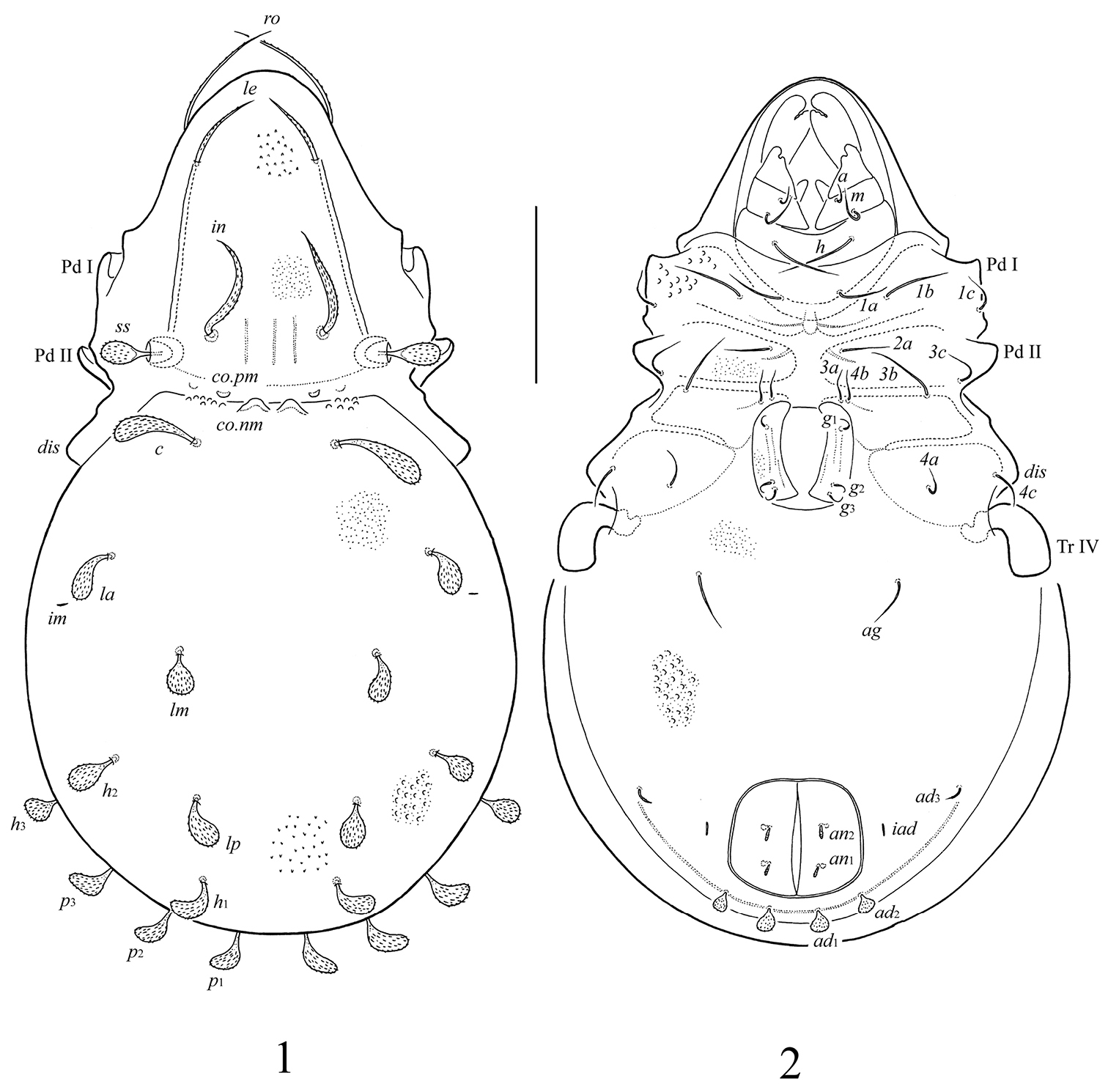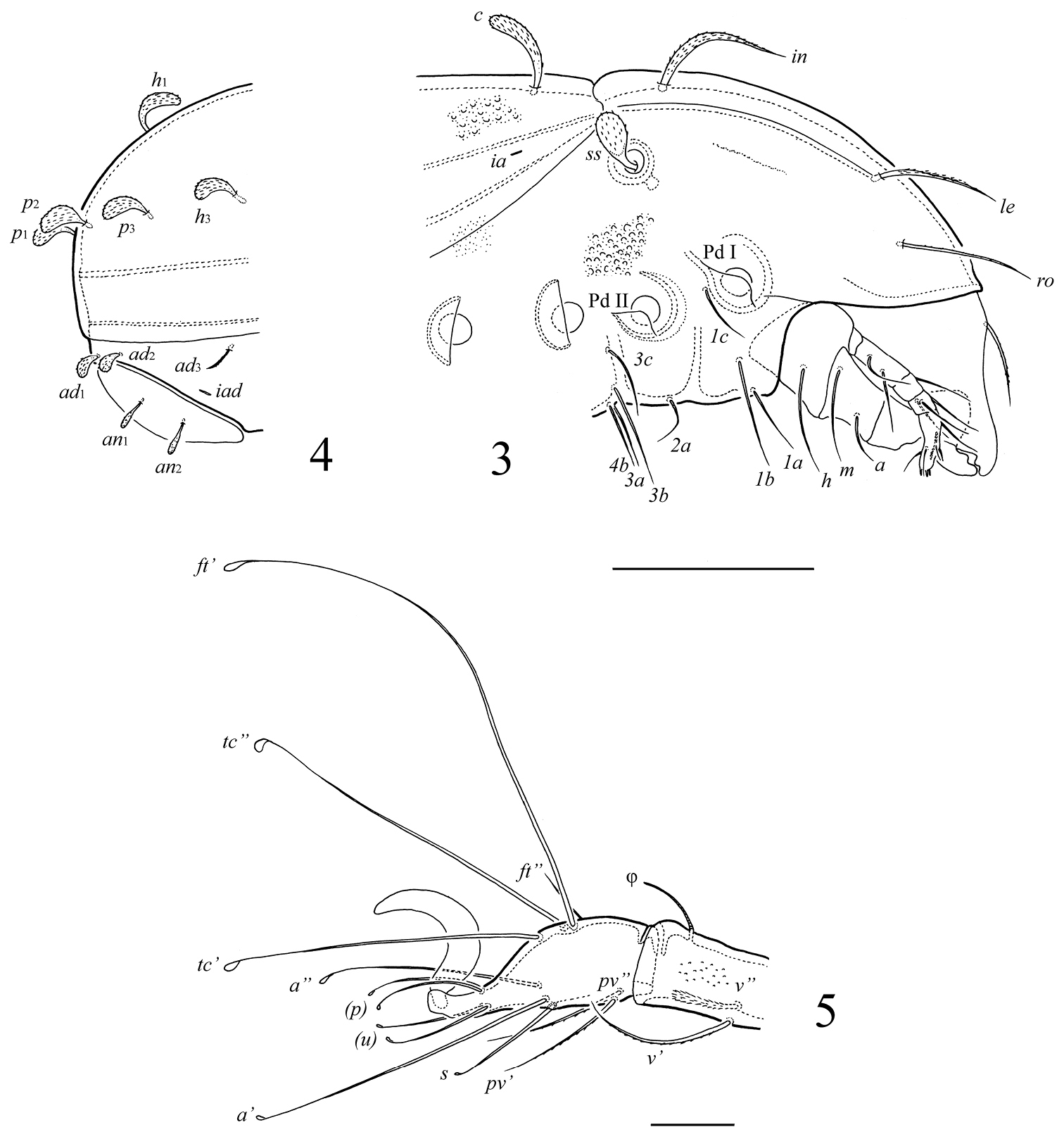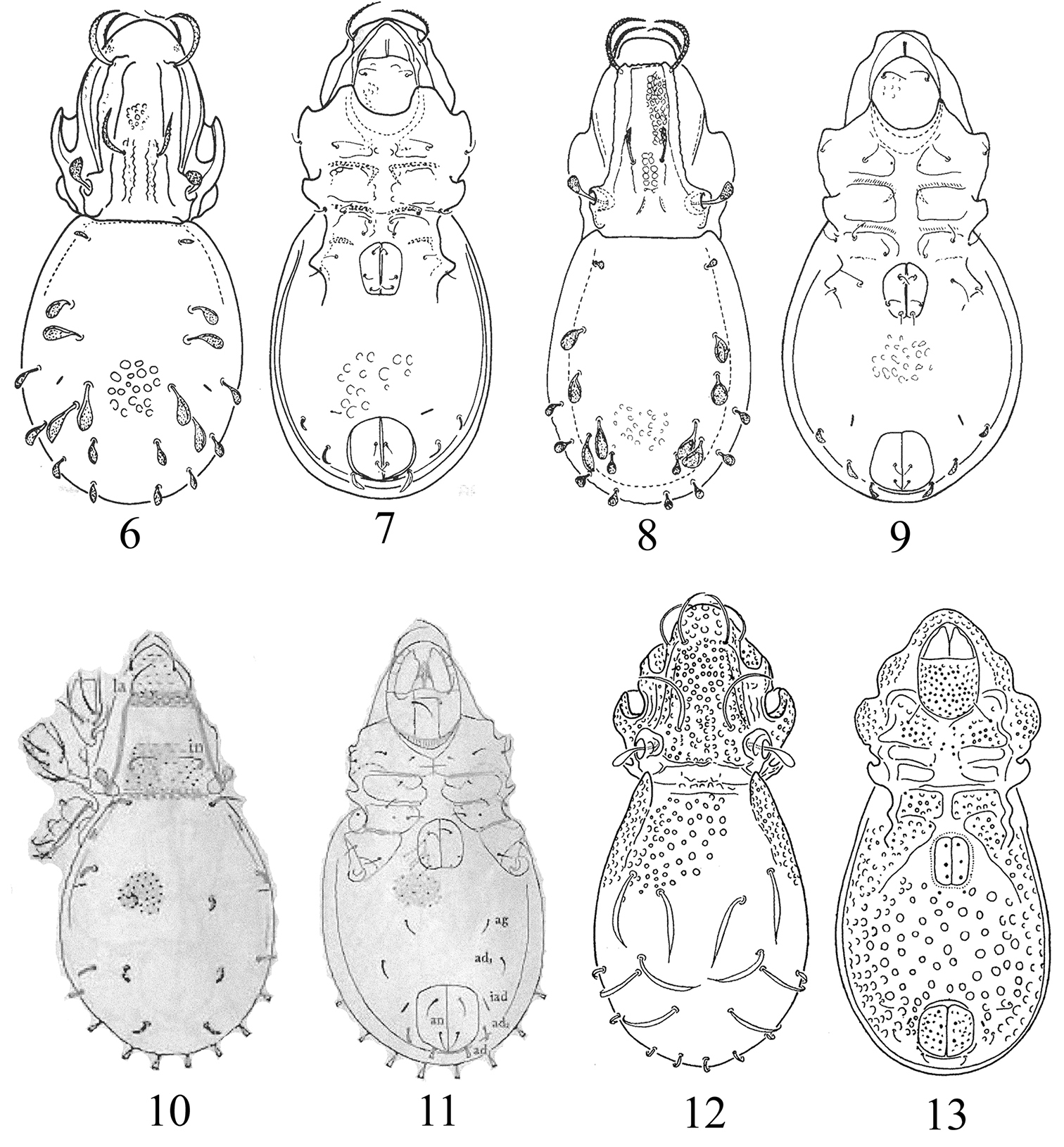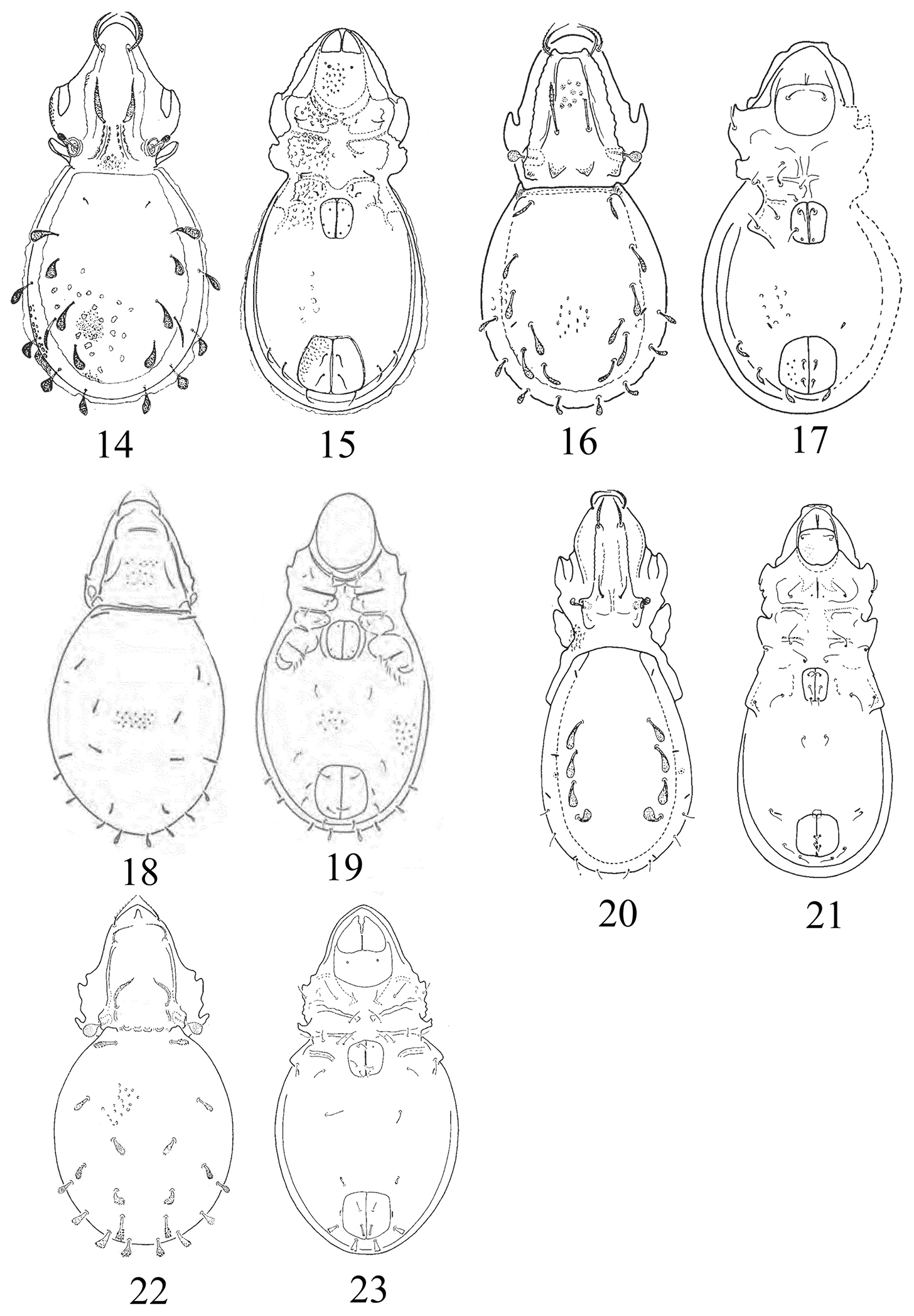






Citation: Ermilov SG, Anichkin AE, Tolstikov AV (2014) The oribatid mite genus Papillocepheus (Acari, Oribatida, Tetracondylidae), with description of a new species from southern Vietnam. ZooKeys 381: 1–10. doi: 10.3897/zookeys.381.6832
The genus Papillocepheus is recorded in the Oriental region for the first time. A new species, Papillocepheus primus sp. n., is described from southern Vietnam; the description is based on specimens collected from semidecayed leaves and litter of Dong Nai Biosphere Reserve and Bu Gia Map National Park. The new generic diagnosis of Papillocepheus and an identification key to the known species of this genus are given.
Oribatid mites, new species, description, Papillocepheus, generic diagnosis, new record, key, Vietnam
Papillocepheus (Acari, Oribatida, Tetracondylidae) is the genus of oribatid mites that was proposed by
In the course of taxonomic identification of Vietnamese oribatid mites collected in October and November 2013 we found one new species, belonging to the genus Papillocepheus. Hence, the genus is recorded in Vietnam and the Oriental region for the first time. The main purpose of our paper is to describe and illustrate this species.
Also, the new generic diagnosis of Papillocepheus and an identification key to the known species of this genus are provided.
Specimens of Papillocepheus primus sp. n. were collected by A.E. Anichkin and S.G. Ermilov in southern Vietnam. Holotype, female: Dong Nai Province, Dong Nai Biosphere Reserve, 11°26'N, 107°26'E, 120 m a.s.l., semidecayed leaves of the Moracea family in a monsoon semideciduous tropical forest on sandy soils near (0.5 m) Dong Nai river, 25.X.2013. Paratype, female: Binh Phuoc Province, Bu Gia Map National Park, 12°11'N, 107°12'E, 539 m a.s.l., leaf litter on ferralitic soils (sifting) in Palm forest on slope of a hill near small river, 14.XI.2013.
All specimens were studied in lactic acid, mounted in temporary cavity slides for the duration of the study, and then stored in 70% ethanol in vials. Body measurements are presented in micrometers. The body length was measured in lateral view, from the tip of the rostrum to the posterior edge of the ventral plate. Notogastral width refers to the maximum width in dorsal aspect. Lengths of body setae were measured in lateral aspect. Formulae for leg setation are given in parentheses according to the sequence of trochanter–femur–genu–tibia–tarsus (famulus included). Formulae for leg solenidia are given in square brackets according to the sequence of genu–tibia–tarsus. Terminology used in this paper mostly follows that of
http://species-id.net/wiki/Papillocepheus
Papillocepheus heterotrichus Balogh & Mahunka, 1966
(based partially on data from:
Tetracondylidae with the following combination of characters: costulae dorsal or dorso-lateral, reach the insertions of lamellar setae; transcostula present or absent; rostral, lamellar and interlamellar setae well developed, setiform or weakly dilated distally or medio-distally; sensilli with short stalk and clavate head; exobothridial setae absent; notogaster with 8–10 pairs of setae, all medium size or short; majority of notogastral setae clearly dilated in distal or medial part, phylliform or willow leaf shaped; medial prodorsal and notogastral condyles usually absent, when present, separated; epimeral formula 3–1–3–3, sometimes some setae absent or represented by alveoli; genital plates with three setae; aggenital setae present or absent; anal plates with two pairs of setae; three pairs of adanal setae present; adanal setae ad3 located in lateral or preanal position; localization of adanal lyrifissures different among types; setae u of all leg tarsi setiform.
http://zoobank.org/CB231C4F-387C-46BE-9C54-0A71399761AD
http://species-id.net/wiki/Papillocepheus_primus
Figs 1–5Body size 498 × 273–282. Rostral setae simple, barbed; lamellar setae shorter, thickened, barbed; interlamellar setae thick, willow leaf shaped, densely barbed. Sensilli with barbed head. Medial prodorsal and notogastral condyles present, notogastral ones located close to each other; lateral prodorsal and notogastral condyles absent. Notogaster with 10 pairs of phylliform setae. Epimeral setal formula: 3–1–3–3. Anal setae dilated in medial part. Adanal ad1, ad2 phylliform; ad3 slightly thickened in medial part, inserted in lateral position. Adanal lyrifissures located in paraanal position, distanced from the anal plates. Most setae on leg tarsi smooth, with swelling in tip.
Measurements. Body length 498 (holotype and paratype: both female); body width 273 (holotype), 282 (paratype).
Integument. Body color yellow-brownish. Body surface and legs covered by granular cerotegument; granules conical (length up to 4). Body surface (including genital and anal plates) densely microfoveolate (diameter of foveolae up to 1). Lateral parts of prodorsum, notogaster and anogenital region additionally with larger foveolae (diameter of foveolae up to 6). Lateral region of body near to pedotecta II and anterior margin of notogaster partially tuberculate (diameter of tubercles up to 8).
Prodorsum. Rostrum simple, widely rounded. Costulae well developed, thin. Transcostula absent. Rostral setae (ro, 69–77) setiform, barbed, inserted laterally. Lamellar setae (le, 49–57) shorter, slightly thicker and more densely barbed than rostral setae, inserted dorso-laterally near the end of costulae. Interlamellar setae (in, 77–86) thick, willow leaf shaped with attenuate tip, densely barbed. Sensilli (ss, 32–36) short, with barbed head. Medial prodorsal condyles (co.pm) small, rounded distally. One indistinct tubercle located laterally to each medial condyle, possibly, it is the second pair of medial prodorsal condyles. Lateral prodorsal condyles absent. Distinct tutorial lines absent.
Notogaster. Medial notogastral condyles (co.nm) of medium size, weakly triangular distally, located close to each other, between prodorsal medial condyles. Lateral notogastral condyles absent. Notogaster with 10 pairs of notogastral setae. All setae widely phylliform; c (45–49) longer than others (32–36). Opisthonotal gland openings and lyrifissures ip, ih, ips poorly visible.
Gnathosoma. Subcapitulum longer than wide: 123 × 94. Subcapitular setae setiform, smooth; h and m (both 57) longer than a (24). Adoral setae absent. Palps (length 82) with setation 0–2–1–3–8(+ω). Solenidion thickened, blunt-ended, pressed to the palptarsus surface, not attached with eupathidium. Chelicerae (length 139) with one barbed seta cha (45); seta chb not evident. Trägårdh’s organ conical.
Lateral podosomal and epimeral regions. Epimeral setal formula: 3–1–3–3. All setae setiform, smooth. Setae 1b, 3b (57–61) longer than other setae (36–41). Discidia (dis) rounded.
Anogenital region. Three pairs of genital (g1–g3, 18–20) and one pair of aggenital setae (ag, 32–36) setiform, smooth. Two pairs of anal setae (an1, an2, 18–20) thickened, dilated in medial part, barbed. Three pairs of adanal setae present: ad1, ad2 (16) phylliform, inserted in postanal position; ad3 (16–18) slightly thickened in medial part, barbed, inserted in lateral position. Adanal lyrifissures iad located in paraanal position, distanced from the anal plates.
Legs. Generally, morphology of leg segments typical for Tetracondylidae (
Leg setation and solenidia of adult Papillocepheus primus sp. n.
| Leg | Trochanter | Femur | Genu | Tibia | Tarsus |
|---|---|---|---|---|---|
| I | v’ | d, (l), bv’’ | (l), v’, σ | (l), (v), φ1, φ2 | (ft), (tc), (it), (p), (u), (a), s, (pv), e, ω1, ω2 |
| II | v’ | d, (l), bv’’ | (l), v’, σ | l’, (v), φ | (ft), (tc), (it), (p), (u), (a), s, (pv), ω1, ω2 |
| III | l’, v’ | d, l’, ev’ | σ | (v), φ | ft’’, (tc), (it), (p), (u), (a), s, (pv) |
| IV | v’ | d, ev’ | d | (v), φ | (ft), (tc), (p), (u), (a), s, (pv) |
Roman letters refer to normal setae (e to famulus), Greek letters to solenidia. Single prime (’) marks setae on anterior and double prime (’’) setae on posterior side of the given leg segment. Parentheses refer to pair of setae.
Papillocepheus primus sp. n., adult: 1 dorsal view 2 ventral view (legs except trochanters IV not illustrated). Scale bar 100 μm.
Papillocepheus primus sp. n., adult: 3 lateral view of prodorsum and anterior part of notogaster (legs not illustrated) 4 lateral view of posterior part of notogaster 5 tarsus and anterior part of tibia of leg I, right, antiaxial view. Scale bar (3, 4) 100 μm, (5) 20 μm.
The holotype is deposited in the collection of the Zoological Institute of the Russian Academy of Sciences, St. Petersburg, Russia; one paratype is in the collection of the Tyumen State University Museum of Zoology, Tyumen, Russia.
The specific name “primus” refers to the first species of Papillocepheus recorded in the Oriental region.
Papillocepheus primus sp. n. can be distinguished from all known species of the genus Papillocepheus by the key, which is presented below.
| 1 | Eight or nine pairs of notogastral setae present | 2 |
| – | Ten pairs of notogastral setae present | 3 |
| 2 | Eight pairs of notogastral setae present (c and h1 absent); notogastral setae la, lm, lp, h2 well dilated distally, phylliform, setae p1–p3, h3 simple; setae lm located posterior to la; adanal lyrifissures in direct apoanal position; body size: 565–620 × 206–261 | Papillocepheus reductus Mahunka, 1994 |
| – | Nine pairs of notogastral setae present (c absent); all notogastral setae weakly dilated in medial part, willow leaf shaped; lm located medio-posterior to la; adanal lyrifissures almost transversely oriented; body size: 503 × 230 | Papillocepheus deficiens J. & P. Balogh, 1983 |
| 3 | Medial prodorsal or/and medial notogastral condyles developed | 4 |
| – | Medial prodorsal and medial notogastral condyles not developed | 6 |
| 4 | Translamella present; lm located posterior to la; aggenital setae absent; adanal lyrifissures in preanal position; body size: 582 × 290 | Papillocepheus longisetosus Mahunka, 2009 |
| – | Translamella absent; lm located medio-posterior to la; aggenital setae present; adanal lyrifissures in paraanal position | 5 |
| 5 | Medial notogastral condyles not developed; adanal setae ad3 in preanal position; adanal lyrifissures located close to the anal plates; body size: 436–471 × 202–224 | Papillocepheus tuberculatus (Mahunka, 1978) |
| – | Medial notogastral condyles developed; adanal setae ad3 in lateral position; adanal lyrifissures distanced from the anal plates; body size: 498 × 273–282 | Papillocepheus primus sp. n. |
| 6 | Notogastral setae lm located dorsally on notogaster, medio-posterior to la; aggenital setae present | 7 |
| – | Notogastral setae lm located dorso-laterally on notogaster, posterior to la; aggenital setae absent | 8 |
| 7 | Adanal setae ad1, ad2 simple; aggenital setae located closer to genital plates than to anal plates; body length: 470 | Papillocepheus neotropicus (P. Balogh, 1988) |
| – | Adanal setae ad1, ad2 dilated distally, phylliform; aggenital setae halfway between genital and anal plates; body length: 500 | Papillocepheus decorus (Hammer, 1966) |
| 8 | Notogastral setae c minute, thin; notogastral setae p1–p3, h3 similar in size to other notogastral setae (except c); adanal setae simple; body size: 715–720 × 353–358 | Papillocepheus heterotrichus Balogh & Mahunka, 1966 |
| – | Notogastral setae c well developed, phylliform; notogastral setae p1–p3, h3 smaller than other notogastral setae (except c); some adanal setae phylliform | 9 |
| 9 | Translamella present; interlamellar setae straight, weakly dilated distally; adanal lyrifissures longitudinal oriented; body size: 482–517 × 221–266 | Papillocepheus decoratus Mahunka, 1994 |
| – | Translamella absent; interlamellar setae curved, willow leaf shaped; adanal lyrifissures transversely oriented; body size: 549–590 × 246–279 | Papillocepheus areolatus Mahunka, 1987 |
Species of the genus Papillocepheus, adult (6, 8, 10, 12 dorsal view; 7, 9, 11, 13 ventral view): 6, 7 Papillocepheus areolatus Mahunka, 1987 8, 9 Papillocepheus decoratus Mahunka, 1994 10, 11 Papillocepheus decorus (Hammer, 1966) 12, 13 Papillocepheus deficiens J. & P. Balogh, 1983. Figures from:
Species of the genus Papillocepheus, adult (14, 16, 18, 20, 22 dorsal view; 15, 17, 19, 21, 23 ventral view): 14, 15 Papillocepheus heterotrichus Balogh & Mahunka, 1966 16, 17 Papillocepheus longisetosus Mahunka, 2009 18, 19 Papillocepheus neotropicus (P. Balogh, 1988) 20, 21 Papillocepheus reductus Mahunka, 1994 22, 23 Papillocepheus tuberculatus (Mahunka, 1978). Figures from:
We cordially thank Dr. Elizabeth A. Hugo-Coetzee (National Museum, Bloemfontein, South Africa) and Prof. Dr. Gerd Weigmann (Free University of Berlin, Institute of Zoology, Berlin, Germany) for the valuable comments. We are thankful to the staff of Dong Nai Biosphere Reserve and Bu Gia Map National Park for support during the field work. The reported study was supported by RFBR, research project No. 14-04-31183 mol_a.



